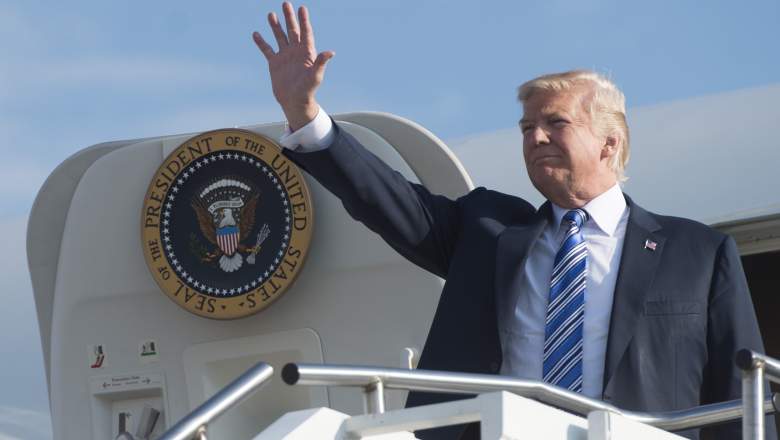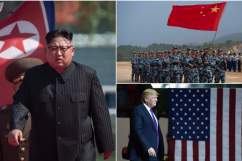
Getty President Donald Trump disembarks from Air Force One upon arrival at Tri-State Airport in Huntington, West Virginia, before his rally.
When President Donald Trump takes the podium Monday to deliver an address to the nation, he’s expected to announce the United States will send an additional 4,000 troops to Afghanistan, Fox News reported.
Trump will reportedly unveil his strategy for the 16-year war in the Middle Eastern country in his remarks, and it will involve boosting the amount of forces deployed by almost half.
Currently, there’s an estimated 8,400 U.S. troops stationed in Afghanistan. If reports are true, that number would increase to nearly 13,000 under the Commander in Chief’s new strategy.
“A big part of tonight’s speech will include ‘asking the region to do more,’ specifically asking India and Pakistan to do more to bring the Taliban to the negotiating table,” a White House official told Fox News.
On August 19, amid scrutiny that his administration has “dragged its feet” on developing a formal strategy, Trump tweeted that he and his advisers had made a decision.
If that strategy involves increasing the forces in Afghanistan, as reported, it would be quite the opposite of what Trump’s long lobbied for, even before announcing his campaign for president.
Trump Has Long Criticized Obama’s Afghanistan Strategy & Encouraged a ‘Speedy Withdrawal’ of Troops
Since 2011, Trump has continuously called out the Barack Obama-led White House for its strategy in the war, which has been ongoing since 2001.
Trump has been critical of not just the War in Afghanistan, but also the Iraq War, saying the government is “wasting” money having troops stationed there. Instead, Trump said the government should use that money to “rebuild the U.S.”
The U.S. has remained stationed in Afghanistan in an effort to assist and train the Afghani troops as they take back their country and has also invested large sums of money to rebuild the country, too.
The Original Withdrawal Plan
In 2011, a development was made in the conflict in the country when Obama announced that he had developed “a clear path to fulfill our mission in Afghanistan.” He announced that the additional 33,000 troops he ordered to the country in December 2009 would return home in 15 months, adding that 10,000 of the “surge” forces would withdraw by the end of the year and the other 23,000 would leave the country by September 2012.

U.S. Marines, left to right, Sgt. Robert Carnes of Lockport, NY, Cpl. Vincent Garcia Jr. of Pasco, WA, Cpl. Zachary Weber of Mt. Healthy, OH and Cpl. Courtney Brown of St. Petersburg, FL with India Battery, 3rd Battalion, 12th Marine Regiment reflect on the loss of Marine LCpl. Francisco Jackson of Elizabeth, NJ as they escort his remains to a helicopter landing pad at Forward Operating Base (FOB) Zeebrugge on October 19, 2010 in Kajaki, Afghanistan.
Obama had long vowed to put an end the the U.S. military involvement started by George W. Bush after the September 11, 2001 terrorist attacks.
Trump said he agreed with Obama on his stance and encouraged a “speedy withdrawal.”
With most of the combat troops gone after 2014, NATO planned to keep 9,800 American forces there to maintain a presence until at least 2016.
Obama specified his plan further, saying that number would drop to 5,500 by early 2017 — the end of his presidency.
However, he switched courses on that strategy when he announced in 2015 that the U.S. would instead keep the troops in the country past his original deadline.
Obama’s reversal came after an “extensive, lengthy review,” he said, adding that an increase in terrorists flocking to the country played a role.
“While America’s combat mission in Afghanistan may be over, our commitment to Afghanistan and its people endures,” Obama said in an address to the nation. “I will not allow Afghanistan to be used as safe haven for terrorists to attack our nation again.”
Trump was critical of Obama’s plan to keep the thousands of troops in the country, accusing him of furthering the conflict.
In addition, he was also adamant that the war should have been over a long time ago, calling U.S. officials “very stupid leaders.”
Trump’s final tweet regarding Afghanistan — aside from Saturday’s — was in 2015 and talked about a suicide bomber that killed a U.S. soldier.
“When will our leaders get tough and smart,” Trump tweeted. “We are being led to slaughter!”
